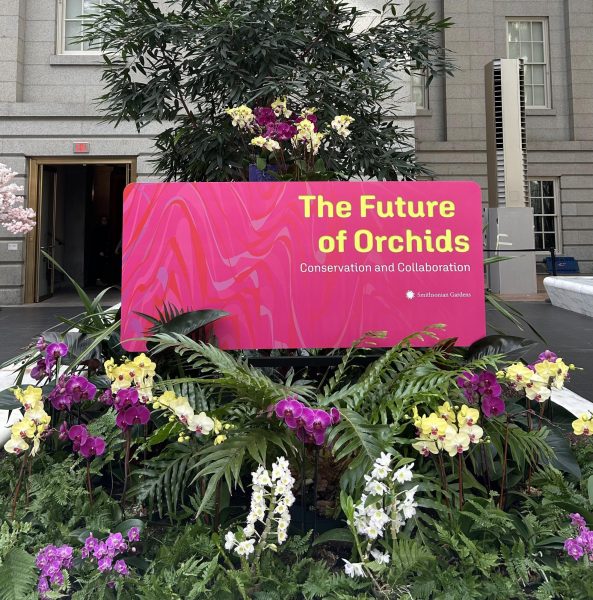Orchids of magenta, vermillion and ochre hues burst into bloom at “The Future of Orchids: Conservation and Collaboration,” a live orchid exhibit that debuted in the National Portrait Gallery’s Kogod Courtyard on Jan. 27.
The exhibit is the 28th annual orchid display presented by the United States Botanic Garden and Smithsonian Gardens, but it is the first to feature original artwork in addition to live plants. The featured artist, Phaan Howng, drew inspiration from human-plant dynamics to create a collection of sculptures and paintings installed alongside the orchids.
In a Jan. 10 press release, Susan Pell, executive director of the U.S. Botanic Garden, said the collaborative exhibit not only highlights the orchid’s stunning appearance but also the problematic loss of biodiversity that endangers orchids around the world.
“It is a joy to continue this collaboration to spotlight the beauty of orchids, the challenges they face and the opportunities we have to save them,” Pell wrote.
Sarah Hedean, living collections manager for Smithsonian Gardens and president of the National Capitol Orchid Society, a local group of orchid enthusiasts, served as the content curator for the new exhibit. Hedean noted that environmentally destructive trends like logging, deforestation, over-harvesting, rising temperatures and habitat fragmentation — when human activities divide an organism’s natural habitat into smaller, discontiguous pieces of habitat — seriously threaten orchid survival and biodiversity.
According to Hedean, environmental degradation particularly endangers orchids because they are interconnected with their entire ecosystem; insect pollinators, healthy soil and fertilizer from animals are all necessary for orchids to flourish.
“If the orchid disappears, many times the pollinator disappears as well,” Hedean told The Hoya. “They say when you find healthy orchids growing in their environment, that shows a healthy ecosystem because all the biodiversity is working together.”
Howng, known for her colorful paintings and immersive art installations, said that the exhibit’s theme of ecological destruction inspired her to create art based on an imagined world where human civilization experiences a climate apocalypse.
“Once we all die off, how would the world restructure itself, and how would the landscape change?” Howng told The Hoya. “I was thinking about how plants would take on even brighter colors to signal warning, about how plants and the landscape militarize themselves.”

While creating her artworks, Howng said she learned about orchid species at the United States National Herbarium and studied mycorrhizal fungi — symbiotic fungi that provide orchids with nutrients by growing at their roots — with the help of Smithsonian researchers.
“Some of the research I did was going to the herbarium, which is located not at the Smithsonian Gardens but at the Natural History Museum,” Howng said. “I also learned more about mycorrhizal fungi and how important they are by reaching out to experts.”
Hedean said that in addition to collaborating with Howng, the new exhibit relied on interdisciplinary contributions from researchers, curators, horticulturists and other Smithsonian collaborators.
“The Smithsonian does so much work with ecosystems, plants, science, education and art, so we really wanted to highlight a Smithsonian perspective on orchid conservation,” Hedean said. “That’s why you see throughout all the panels in the exhibit a lot of different stories about folks within the Smithsonian and the work they’re doing, whether in the U.S. or Panama or wherever in the world they might be working.”
Hedean said that along with the Smithsonian, organizations like Ecuaganera, an Ecuadorian orchid company that sustainably grows and sells orchids through a propagation program, are working to protect the nearly 30,000 species of naturally occurring orchids that exist around the world.
“These propagation programs are helping to reduce a lot of habitat loss as well as making sure the price drops by making them more available,” Hedean said. “There’s no longer the pressure of being able to get $1,000 if you take an orchid out of its environment if you can now get it for $80 when it’s ethically and consciously produced.”
Howng said she hopes that the exhibit’s breathtaking beauty and engaging educational elements will encourage visitors to support orchid conservation initiatives.
“I’m hoping that if people are attracted to these very attractive flowers that are also very diverse and interesting-looking, that interest will become something where people will say, ‘We want to save these orchids and see them thrive in the wild,’” Howng said.









